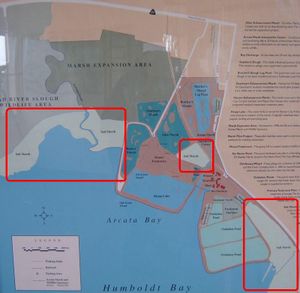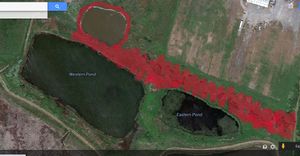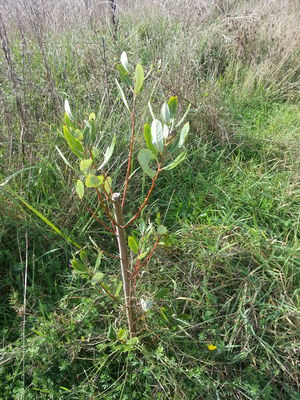
A saltwater marsh is a specific ecosystem with benefits to humans and the environment. A low-lying, nearly level coastal grassland governed by the seasons and the tides, saltwater marshes are one of the most productive areas in the world. They are found on the edges of estuaries which, unlike swamps, are more shallow. Estuaries are the places where rivers meet oceans, and are enjoyed by people for homes, fishing, hunting, swimming, and for wildlife observation. Saltwater marshes have the benefits of filtering estuary water of sediment and toxins and acting as storm surge protection for more diverse upland regions.[1][2]
Arcata's saltwater marshes have been restored so they are not naturally-occurring. However, Arcata's saltwater marsh does contain typical grasses and organisms. Also typical is this ecosystems original destruction by human settlement. Unlike many saltwater marshes, the Arcata/Eureka saltwater marshes aren't used as protection for the inland areas from storm surges because of the protection provided by Humboldt Bay.[3]
Overview[edit | edit source]

Arcata's Saltwater Marshes are part of the Arcata Marsh system in that they serve as a refuge for species of birds and other animals that are enjoyed by watchers. See Figure 1 for a layout of the saltwater marshes in this overview of the Marsh system.
Saltwater Marsh Background[edit | edit source]
Marshes are daily and seasonally affected by water-level changes causing effects in salinity, temperature, and water depth; thus oxygen content and general growing environment are changing considerations for inhabitants. Temperature affects oxygen content via increased or decreased gas solubility and via biological activity. Increased salinity further decreases oxygen handling of water. Temperature and salinity changes from tidal influx slows growth. Seasonal fresh water influx delays to seasonal tidal influx by a few months in the spring, causing an elongated period of cooling of the ecosystem. This occurs during the spring seasons productive plant growth.[4][5]
Water flows slowly in the marsh due to gradual slopes and plant/organism networks, so sediment is deposited. Sediment deposits build up enough to support plant species that otherwise wouldn't grow in saltwater marshes. Sediment can consist of organic matter (salt marsh peat). The sediment is however low in nutrient content, being depleted of nitrogen by microbes. It is high in cellulose, however, which is doubled in protein density when it is broken down.[6]
Plant and animal roles[edit | edit source]
A few grass types grow in lower and upper marsh zones, which are characterized by salt and under-water tolerance. They are able to excrete salt from their leaf surfaces, and some send salt to their extremities which break off at the end of each growing season. These grasses are able to exchange oxygen to and from roots, which are underwater, by means of their aerenchymal (airy, gas-exchanging root) tissue. Further aiding gas exchange in some species is a mechanism for sending salt to the roots/stems, where it's higher concentration than the surrounding water enables osmosis of water into roots.[7]
Organisms such as marine mollusks and other animals consume primary producers and consumers. Their feces, rich in nitrogen, helps fertilize the marsh grasses.
Concerns and the Future[edit | edit source]
Over half of the nation's people now live and work within coastal counties. Their cumulative impact can be significant on salt water marshes. Destruction can be caused by filling of marshes for new homes, ditching to control mosquitoes, diking to create impoundments and building canals for flood control. In Arcata's case, European settlement contributed to 90% saltwater marsh destruction. Since 1980, 50 new acres have been reinstated with a new marsh to be built from funds from the Environmental Enhancement and Mitigation Program on 75 acres.[8][9][10]
In the news[edit | edit source]
2007: A new study reveals that a salwater marsh island near New York City could vanish within the next 5 years due to sewage dumping.[11]
2001: Researchers find evidence that potentially hazardous fecal bacteria from seagulls could pollute recreational beaches in California. Saltwater marshes, a seagull habitat known to filter pollutants from the environment, may be flowing too quikly to effectively filter the pollutant.[12]
2000: Drought causing record low water levels in the Mississippi River combine with unusually low summer tides in Lousiana to cause saltwater marsh conversion to mud-flats. The solution, according to the Governor, is in monitoring wetland conditions and optimizing management of available fresh water.[13]
Willow Planting[edit | edit source]


On February 15th, 2014, a joint project involving Humboldt Fish Action Council, City of Arcata, Watershed Stewards Project, the California Conservation Corps, and Cal Poly Humboldt Natural Resources Club took place. A group of 50-60 volunteers from these organizations and the Arcata community planted a few thousand Arroyo willow sprigs, which were harvested from existing willow plants in the Arcata Marsh.
Willow planting is a common ecological restoration technique in California, which is done for purposes of bank stabilization and habitat improvement. Arroyo willow can act as a food source, cover, and nesting structure for wildlife.[14] In the Arcata Marsh, the primary goal was to improve wildlife habitat. During the 2014 event, sprigs were deliberately cut longer than usual - about 3-4 feet - as one of the organizers found this technique equally successful at taking root (compared to 2 feet cuttings) and faster in generating cover. Bottoms of sprigs were clipped in at a sharp angle so as to produce a point capable of driving out air pockets when inserted into the ground. Holes were created using willow bars, then the sprigs were inserted by hand or with wooden mallets, with careful attention to clip off split tops from hammering (a split top is believed to kill the sprig). All sprigs were inserted at least one third of their total length into the earth to ensure best chances of successful rooting. The event took about four hours.
On October 15th, 2014, the sprigs looked like they were doing well. New foliage has appeared, although they aren't capable of providing much cover or habitat yet. It appeared that the majority of the sprigs took, excluding a portion which appear to be situated over an old cement building foundation, which prevented them from tapping into the water table.
See also[edit | edit source]
- Chinampa
References[edit | edit source]
- ↑ New Hampshire Department of Environmental Services- Coastal Program. Document number WMB-CP-06, 2004. “What is a Salt Marsh?” Weblink: http://web.archive.org/web/20070714015736/http://www.des.state.nh.us/factsheets/cp/cp-06.html
- ↑ Defenders of Wildlife © Copyright 2008. Webpage: Wildlife and Habitat. “Wetlands Factsheet.” Weblink: http://web.archive.org/web/20120226084631/http://www.defenders.org:80/wildlife_and_habitat/habitat/wetlands.php
- ↑ Wikipedia.com: Humboldt Bay http://en.wikipedia.org/wiki/Humboldt_Bay_(United_States)
- ↑ U.S. Department of Energy, Argonne National Laboratory, Division of Educational Programs. NEWTON: an electronic community for Science, Math, and Computer Science K-12 Educators. ‘Ask a Scientist’ section, discussion webpage. Weblink: http://web.archive.org/web/20150226040028/http://www.newton.dep.anl.gov/askasci/gen01/gen01463.htm
- ↑ Journal of Coastal Research, Northern Ireland. ISSN 0749-0208 Weblink: http://web.archive.org/web/20060208094655/http://www.science.ulst.ac.uk:80/ics2002/moller%20and%20spencer.pdf
- ↑ Tramline Inc.- “Salt Marshes Field Trip” Copyright © 1996-2007. Weblink: http://www.field-trips.org/sci/salt
- ↑ Cal Poly Humboldt ERE Department. Arcata Marsh and Wildlife Sanctuary Webpage: “Saltwater Vegetation.” Weblink: http://web.archive.org/web/20080509144514/http://www.humboldt.edu/~ere_dept/marsh/saltveg.html
- ↑ Orlando Sentinel, Rob Young, Feb 24, 2008. "A bleak future for Saltwater Marshes" Weblink
- ↑ Planet Ark.com, Jan. 17, 2005. "Green Groups Hope Suit Forces US Hand on Warming" by Timothy Gardner. Weblink: http://web.archive.org/web/20130925153138/http://www.planetark.com/dailynewsstory.cfm/newsid/29018/story.htm
- ↑ Arcata Marsh Interpretive Center, 600 S G St Arcata, CA 95521
- ↑ Discovery Communications, LLC DBA Treehugger.com © 2008. “Could NYC's Saltwater Marshes Disappear Within the Next Five Years?” by Jeremy Elton Jacquot, Los Angeles, August 3rd, 2007. Weblink: http://web.archive.org/web/20090407210110/http://www.treehugger.com/files/2007/08/could_nycs_saltwater_marshes.php
- ↑ American Chemical Society (2001, June 4) ScienceDaily LLC Copyright © 1995-2008, Web article: “Unusual Source Of Ocean Water Contamination May Rewrite Environmental Textbooks.” Weblink: http://www.sciencedaily.com/releases/2001/05/010529235649.htm
- ↑ LaCoast website maintained by USGS National Wetlands Research Center, funded by the Coastal Wetlands Planning, Protection and Restoration Act (CWPPRA) of 1990. (Lousiana) “Governor's Saltwater Marsh Die-Off Action Plan Executive Order No. MJF 2000 - 41.” Weblink: http://www.lacoast.gov/news/press/2000-11-07a/index.htm
- ↑ River Partners, riverpartners.org. “Riparian Plants: Arroyo Willow - Salix lasiolepis”. Weblink: http://web.archive.org/web/20180909064700/http://riverpartners.org:80/resources/riparian-ecology/veg-wildlife-habitat/ecological-tolerances/arroyo-willow.html
Credits[edit | edit source]
Created by Aaron Parker, ERE 115 student, Cal Poly Humboldt